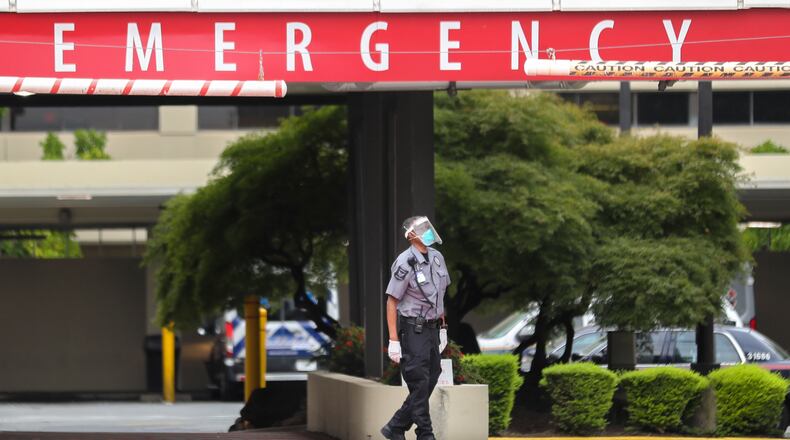The state’s health care system continues to operate in crisis mode as hospital intensive care units still overflow with gravely ill patients, even though COVID-19 admissions have declined since hitting a pandemic peak in early September.
The high demand for critical care has pushed hospitals to try to limit ambulance traffic to their severely crowded emergency departments. The result: frequent scenes of ambulances piling up outside ERs, as EMS workers keep caring for patients on stretchers and listening to radio calls they can’t quickly respond to.
“You think, ‘There goes another cardiac arrest, and I’m standing there twiddling my thumbs in a hospital hallway when I could have been helping that person in distress,’” said Chuck Kearns, CEO of Chatham Emergency Services in Savannah.
And though overall COVID-19 cases have edged down, emergency medical and hospital officials told The Atlanta Journal-Constitution they worry the decline may be temporary. Cases may balloon again over the next few weeks as a result of Labor Day celebrations, the return to in-person school and the start of college and high school football games that are attracting large crowds.
Wednesday, Georgia reported 4,227 new confirmed cases, 258 hospitalizations and 166 confirmed deaths, according to the Georgia Department of Public Health.
Statewide, nearly a third of all hospitalized patients — totaling 5,327 — were being treated for COVID-19. That is a drop from the pandemic peak of just over 6,000 two weeks ago.
But that hasn’t lessened the load in intensive care units, which have to handle the sickest COVID-19 patients along with other critically ill Georgians. Statewide, intensive care units were at 96% of capacity on Wednesday. However, in five of Georgia’s 14 hospital regions, ICUs were over 100% capacity.
“People early on with the delta variant said, ‘Well, people don’t get as sick and they’re not going to require as many hospitalizations,’ and all that has been proven wrong,” said Dr. Robert Jansen, chief medical officer of the Grady Health System. Jansen said patients are getting just as sick if not sicker in this surge, and people in their 40s and 50s are routinely among those whose lives are threatened.
“It’s devastating,” he said.
Grady Memorial Hospital had to pause some surgeries that could be safely delayed so that its recovery rooms could be converted to intensive-care beds to handle the patient load.
“People early on with the delta variant said, ‘Well, people don't get as sick and they're not going to require as many hospitalizations,' and all that has been proven wrong."
Adding to the stress, every hospital in the state is dealing with staffing shortages and the frustration of frontline staff working extra shifts at a time when vaccines are widely available.
“It’s terrible for the smaller hospitals in rural areas in particular,” Jansen said. “When every ICU bed in Atlanta is full, you can’t take additional patients. We have had calls and we have had to say no, we can’t take additional patients right now.”
Large hospitals across the state also are strained.
Credit: JOHN SPINK / AJC
Credit: JOHN SPINK / AJC
“We are still admitting COVID patients every day, and we are still caring for far too many critically ill patients,” said Scott Steiner, CEO of Phoebe Putney Health System in Albany, whose flagship hospital has 691 beds. “Don’t be the one who thinks that can’t happen to you.”
University Health Care System in Augusta, with 812 acute care beds at two hospitals, tried to shift its resources so that patients can get the level of care they need.
“Staffing available beds continues to be our greatest challenge,” said Reyne Gallup, University’s executive vice president and chief operating officer for acute care services. “We are working hard to keep our teams uplifted and supported. We have the most dedicated people I have ever worked with, and I’m proud of them every day.”
It’s not just COVID-19 that is putting pressure on the health care system. Grady is a top trauma center that excels in handling certain types of emergency cases, including burns and strokes, and it has to be ready for those patients at all times. The increase in violent crime in Atlanta is also sending more patients with gunshot wounds and other injuries from violence to Grady.
“We kept hoping it would get better and it’s not,” Jansen said. “In fact, we set records almost every month for the number of trauma patients coming in.”
The consequences of the hospital backup can be severe.
Last week, Savannah ambulances were held up at hospital ERs at least 15 times a day, said Kearns, of Chatham Emergency Services. That meant EMS on multiple occasions could not respond to emergency calls. Those may have included cries for aid from patients suffering cardiac arrest, stroke and other life-threatening conditions, he said.
“EMS agencies are struggling just like the hospitals are,” Kearns said.
The situation was even worse in mid-August, he said. Excessive wait times at the emergency rooms meant that up to 24 times a day ambulances could not respond to calls.
“You’re seeing a lot of people complaining about EMS response times,” said Steve Vincent, vice president of Gold Cross EMS in Augusta. “Well, that’s all over the country.”
Chad Black, chairman of the Georgia EMS Association and director of Habersham County EMS, said ambulances usually are able to quickly unload patients in critical condition. But the typical hold time for ambulances at hospitals in many regions of the state is four to five hours, he said. “It’s just putting a severe strain on an already fragile component of the healthcare system, which is prehospital EMS,” Black said. “So it has a huge effect on us.”
Staffing has also been a major problem for EMS statewide, Black said. COVID-19 has sidelined some workers. Black is very worried right now because one of his medics is in the ICU with COVID-19 pneumonia. “That is an EMS director’s worse nightmare,” he said.
And burnout is taking a toll, said Pete Quinones, president and CEO of Metro Atlanta Ambulance Service, based in Marietta.
“We’re doing the best we can with what’s available,” Quinones said. “We have a lot of employees who are fatigued and rightfully so. This has been going on for 20 months, and it’s got ups and downs. Right now we’re definitely struggling.”
The Latest
Featured




